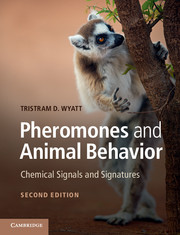Book contents
- Frontmatter
- Dedication
- Contents
- Preface to the second edition
- Acknowledgments
- List of SI prefixes
- List of Abbreviations
- 1 Animals in a chemical world
- 2 Methods for identifying and studying semiochemicals
- 3 Pheromones, chemical cues, and sexual selection
- 4 Coming together and keeping apart: aggregation pheromones and host-marking pheromones
- 5 Territorial behavior and semiochemicals
- 6 Semiochemicals and social organization
- 7 Pheromones and recruitment communication
- 8 Fight or flight: alarm pheromones and cues
- 9 Perception and response to chemical communication: from chemosensory receptors to brains, behavior, and development
- 10 Finding the source: pheromones and orientation behavior
- 11 Breaking the code: illicit signalers and receivers of semiochemicals
- 12 Using semiochemicals: applications of pheromones
- 13 On the scent of human attraction: human pheromones?
- Appendix An introduction to chemical terms for non-chemists
- References
- List of Credits
- Index
6 - Semiochemicals and social organization
Published online by Cambridge University Press: 05 June 2014
- Frontmatter
- Dedication
- Contents
- Preface to the second edition
- Acknowledgments
- List of SI prefixes
- List of Abbreviations
- 1 Animals in a chemical world
- 2 Methods for identifying and studying semiochemicals
- 3 Pheromones, chemical cues, and sexual selection
- 4 Coming together and keeping apart: aggregation pheromones and host-marking pheromones
- 5 Territorial behavior and semiochemicals
- 6 Semiochemicals and social organization
- 7 Pheromones and recruitment communication
- 8 Fight or flight: alarm pheromones and cues
- 9 Perception and response to chemical communication: from chemosensory receptors to brains, behavior, and development
- 10 Finding the source: pheromones and orientation behavior
- 11 Breaking the code: illicit signalers and receivers of semiochemicals
- 12 Using semiochemicals: applications of pheromones
- 13 On the scent of human attraction: human pheromones?
- Appendix An introduction to chemical terms for non-chemists
- References
- List of Credits
- Index
Summary
The most complex animal societies described so far are found among the mammals and social insects. The individuals in these societies interact via a complex web of semiochemicals. In mammals and social insects, each individual’s chemical profile consists of molecules produced by the animal itself, together with molecules acquired from the environment and from other group members. The resulting chemical profiles are complex and variable mixtures, giving a forest of peaks on a gas chromatograph trace, in contrast to the small number of defined peaks for the sex pheromones of moths and other insects (Chapter 1) (Figures 1.1, 1.2, and 13.2) (Wyatt 2010).
The chemical profile includes the colony or group odor that gives each member access to the group. In addition, within the overall chemical profile there are the species-wide pheromones. For example, on top of its individual odors, the saddle-back tamarin, Saguinus fuscicollis, a South American primate, produces pheromones that identify species, subspecies, sex, and social status within the group (Epple et al. 1993). As well as their colony odors, social insects carry pheromones on their cuticle that include information about their species, caste, age, and sex. In social insects, pheromones reflecting reproductive status, in particular fertility, may regulate reproduction of workers who do not themselves reproduce but instead help the queen (Section 6.2). Pheromones do not appear to have this role in social mammals.
- Type
- Chapter
- Information
- Pheromones and Animal BehaviorChemical Signals and Signatures, pp. 126 - 149Publisher: Cambridge University PressPrint publication year: 2014
- 1
- Cited by



